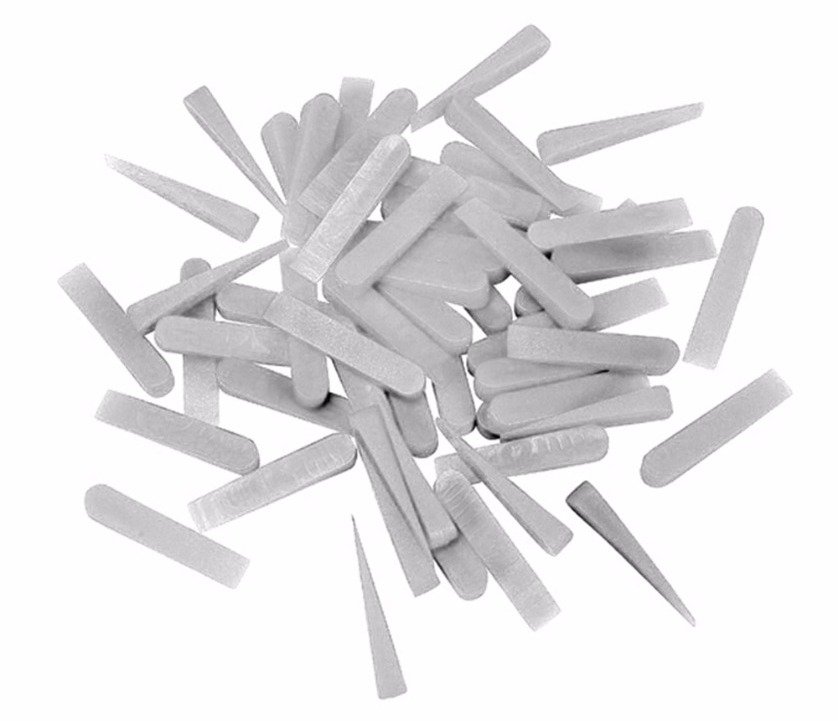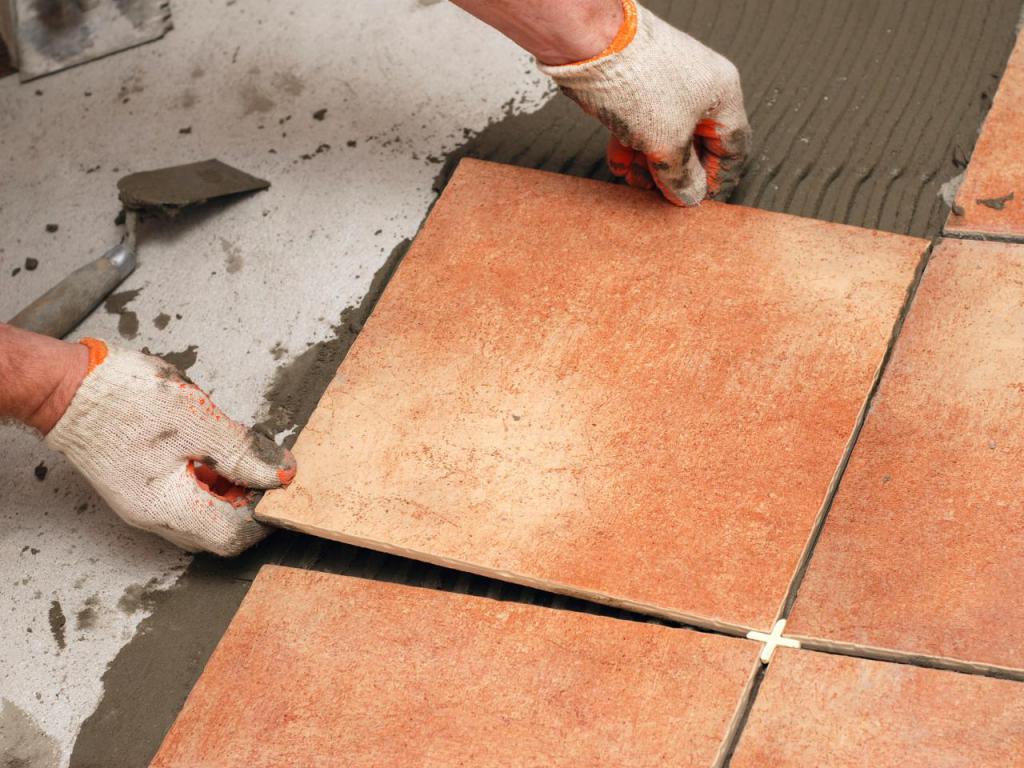The widespread use of tiled crosses is fully justified. Without these small details, beautiful and even seams simply will not work. Crosses for laying tiles - an integral part of the work associated with the installation of tiles, regardless of its size and texture. In addition, not only the quality of the tile laying, but also the simplification of the work largely depends on the correct choice of this consumable.
Appointment
The main purpose of the crosses for tiles is an aesthetic inter-tile seam. But there are other functions:
- They help to level (or hold) the horizontal and vertical level of the tile. And this is important, given the flaws in production, which is very common.
- Limit the "walking" of neighboring tiles, fixing the desired size seam.
- A seam formed by a cross compensates for the difference in thermal expansion between the tile and its base.
- Crosses for tiles are able to hide the difference in ceramic size, especially when using more than two types of tiles. Differences of up to 1.5 mm are often found even on tiles from the same collection.
- Allows you to align the edges of the tiles in one plane, excluding subsidence during glue drying.
These are the main points that you should pay attention to when deciding whether to use crosses or not.
Types of crosses for tiles
First of all, they are divided into corpulent and hollow products. Both the first and second come in different sizes and shapes. There are no significant differences between them, the choice is determined by the preference of the master.
Mostly crosses are:
- Cruciform - have the shape of a cross. The most common form for the classic laying of ceramics due to its affordability and low cost.
- T - shaped, mainly used when laying in the run. If desired, you can make it yourself by cutting off one of the rays of the cross-shaped crosses.
- Wedges are a less common option as fixing sutures. If only for a very uneven tile. Mainly used in the installation of the first row of wall tiles, to adjust the horizontal level. For floor tiles - as a wall retainer. It is also possible to use for leveling the thickness of the inter-tile seam.
- SVP - tile alignment system. It is better known as 3D crosses. It appeared on the Russian market relatively recently. They are less common due to the higher price compared to standard options (about 7-8 times).
3D crosses
Consist of a wedge and clamp. When tightening the clamp into the wedge, the surface is conditionally aligned. According to manufacturers, using 3D crosses for tiles, any beginner can easily do this job.
Let’s figure out whether it is worth believing the brochures?
- Acceleration of works on facing 4 times. A very dubious plus, since the main work of the tiler is not to put in crosses. And even with little experience, exposing these consumables will take a minimum of time.
- You will get a perfectly flat surface, the seams will not differ from each other and the like. There is some truth in this, but only for tiles that are ideal by all criteria, which you do not often find. The surface of the cladding can in no way depend on crosses, and the even seams between the tiles directly depend on the side faces of the tile and the difference in diagonal dimensions.
- The high price is easily compensated for by saving on hiring specialists (that is, the work can be done independently). It turns out that it is the purchase of 3D crosses that determines the level of skill in laying tiles, which, of course, does not correspond to reality.
- Keeps tile from subsidence. Now this is more like the truth, since there really are moments of subsidence of the tile (especially the corners), but it also depends on the quality of the tile. It happens in one batch (and sometimes in one pack) both concave and curved tiles are found. In such a situation, the purchase of this system will be an extra waste of the budget. The same thing with the participation of tiles of different thicknesses (for example, a regular plate and decor) - the use of 3D crosses for tiles will be unjustified.

The application of this system is very limited and effective, it will only be for high-quality tiles on a flat surface with a minimum layer of glue.
Tiled Wedges
They are not exactly crosses (in the usual sense) and are mainly used to correct the first row of wall tiles and keep the distance from the wall for flooring, since crosses for tiles on the floor can not cope with this task.
But their application does not end there:
- Local thickening of the seam, that is, a deliberate increase in its size in one place. This application is justified when there is a noticeable difference (more than 0.5 mm) between the parallel edges of the tile along the length, and this action is required to maintain the horizontal or vertical level.
- Also used in the installation of artificial stone, to maintain an even horizontal line of the seam. Since artificial turf can vary in size up to 5 mm.
- For laying skirting boards around the perimeter of the room. The upper edge of such a skirting board should create a visually even line, and it is extremely difficult to achieve such an effect without the use of wedges. This is due to the fact that the tile for the skirting board is mainly subjected to sawing, which means that the uneven lower edge is quite likely.
- Wedges are almost indispensable for facing steps. They help to align the seam between the tiles on the outer and / or inner corner.

They are made of plastic and have different sizes. Of course, it is quite possible to do without them, but their application will greatly simplify the process.
How to use?
How many people, so many opinions. This is how you can characterize this topic. It mainly depends on the tiler's preferences, and each of them will uphold his own method:
- The use of eight crosses on one tile, that is, two on one side.
- Setting crosses at the intersection of tile seams.
- Installation of crosses for laying tiles in the middle of the product.
No matter how you use these consumables, the main thing is to try to achieve the most even seams and crosshairs. After all, this is precisely their main purpose. After the glue has dried, crosses and wedges must be removed. This can be done with a paint knife or pliers.
Sizes of crosses for a tile
The size of the inter-tile seam directly depends on the thickness of these consumables, so this issue is no less important than other aspects.
The sizes are very diverse:
- In thickness are from 1 to 10 mm. The most popular of them - from 1.5 to 3 mm (for walls and floor).
- The width, length or height (meaning the size of the cross) is usually 10-12 mm, but there are more options. This setting is manufacturer specific.
- The number of crosses in a package varies from one manufacturer to another, but basically it is 50, 100, 150, 200, 250 and 500 pieces in one package.
How to choose the right one?
It is not very clear where the information came from that the size of the thickness of the crosses directly depends on the size of the tile. Even a certain formula is given: the length of the tile in mm is divided by 100 and the required thickness of the cross is obtained. The proof is that the correction on a wide seam is easier and more inconspicuous. And if the tile, for example, is 60 x 120 cm (600 x 1200 mm), then crosses need 12 mm? And besides, any correction of a seam more than a millimeter on a long tile will be noticeable regardless of the size of the crosses.
Therefore, when choosing, we advise you to pay attention to the following:
- The design of the tile (or the room as a whole), its quality, and, last but not least, the dimensions, can conditionally affect the choice of cross size. But the basis of the choice is the wish of the customer himself.
- Do not rely on such a factor as price, that is, the more expensive, does not mean that it is better, but you should not buy the cheapest material.
- It is advisable that the consumables are not too hard or too soft. Excessively stiff crosses for tiles are very brittle, and the latter can be washed in the seam under the weight of the tile and thereby “remove” the horizontal level.
- It should be noted that a too wide seam is more prone to contamination (with light tones of the grout), cracking (when using low-quality grout). In addition, the consumption of material increases.
- The most popular crosses for walls are 1.5-2 mm, for the floor - 2-3 mm. If necessary, it is advisable to purchase from the same manufacturer, since crosses of the same size, but different manufacturers may have differences in thickness, and this will adversely affect the tile.
- It is also an important fact: for tiles with bevels on the side faces, the thickness of the seam will increase by 0.5-1 mm, that is, if you put a cross to the full length, then instead of 2 mm we get a seam of 2.5-3 mm.
Is it possible to do without them?
The answer is unequivocal - it is possible, and sometimes even necessary. Tile without crosses is laid mainly in two ways:
- With seams - the tile is laid, as usual, only without the use of consumables. That is, the width and evenness of the seam are determined visually ("by eye") by the contractor. First of all, it depends on the professionalism of the tiler, as well as on the walls and composition of the adhesive mixture.
- A seamless way - the tile joins close to each other, leaving a minimum gap of 0.5-1 mm, which is rubbed with an epoxy-based grout. The grout is matched to the tone of the tile, and the joints are almost invisible, a monolithic surface is obtained. But this method requires the most even tile and surface for laying. More suitable for large porcelain stoneware with smooth, bevel-free edges.
Consumption
It directly depends on the chosen method of application, the size of the tile, as well as on the quality of the crosses themselves:
- Good consumables can be reused after they are removed from the wall, but provided that they are kept in the correct shape.
- The larger the tile, the less crosses will be needed for the same volume.
- Since the price of regular crosses is low, you should not be too scrupulous in approaching this issue.
- It is better not to waste time and buy them with a small margin, 2-3 packs will be enough for a standard bathroom.
In conclusion, I would like to add that if this is your first experience in laying tiles, then still use this consumable. In the process, you yourself will understand which crosses for the tile you need. The choice is always yours, just remember that any crosses (even 5D) will not be able to replace the hands of a professional master. And experience is gained only in practice.